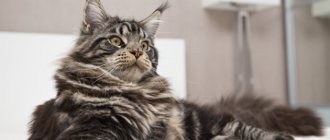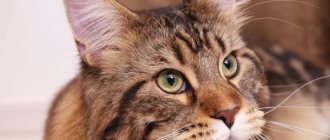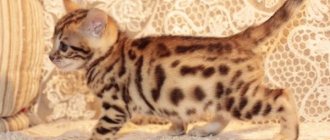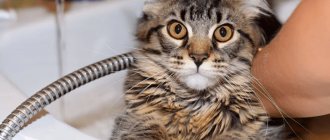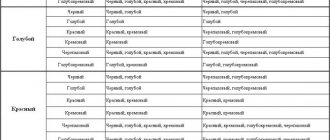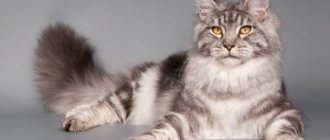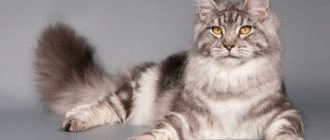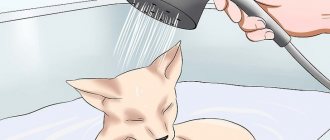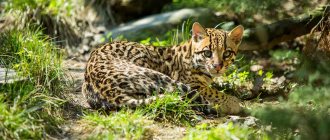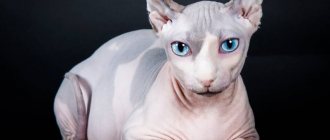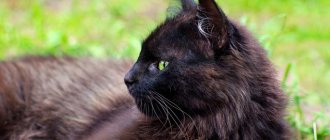Care and maintenance
The raccoon cat, or Maine Coon, requires special care. If we recall the description of its representatives, they have long hair, large sizes and a good appetite.
Maine Coon
Caring for a Maine Coon is not an easy task, so before you bring such a handsome dog into your home, you should think carefully about whether a person can devote a lot of time and effort to the animal.
This breed has a number of positive traits. These cats are smart, trainable, get along well even with small children, are clean and quickly adapt to the habits and behavior of their owner. The only drawback is the high maintenance requirements.
Basic conditions that must be met:
- Regular cleaning of the eyes from accumulated mucus. It appears even in a completely healthy animal;
- cleaning the ears. The area is quite delicate, so the procedure is carried out carefully so that the animal does not jerk and harm itself. Healthy and clean ears are pink in color, without foreign accumulations;
- the pet's long hair requires daily combing using a special comb;
- Claws should not be allowed to grow to too large a size. Otherwise, they will cause inconvenience to the pet.
Grooming
Caring for teeth, nails, eyes and ears
It is up to the owner to take care of the health of his pet’s teeth. To do this, follow simple recommendations:
- feed your pet solid food, it helps strengthen gums and teeth;
- if necessary, give the animal special vitamin complexes rich in minerals that strengthen the cat’s claws and teeth;
- purchase a children's toothbrush, a special paste for cats, and carry out the procedure for cleaning the cat's mouth yourself once every 20-30 days.
Overgrown claws cause Maine Coons a lot of inconvenience, so it is worthwhile to accustom your pet to the scratching post in a timely manner. You should also have special rounded scissors at home for cutting broken or very long nails.
To maintain eye hygiene, regular examinations should be carried out; using cotton wool or a cotton pad, the eyes are wiped with clean water or a special solution every day.
The auricle should be light in color. You can carefully remove wax yourself using an ear stick. If black plaque is present, you should contact your veterinarian.
How to feed a Maine Coon so it grows big
American Maine Coon, European Maine Coon
Despite the size of the animal, the stomach of Maine Coon cats is not very large. The option of three meals a day is suitable. For a female, the daily norm is about 250 kcal, and for males 300 kcal. It is worth giving food at the rate of: 30 g of food per 1 kg of weight.
For your information! An adult Maine Coon eats approximately 1.5 times more than a regular breed cat.
In order for the Maine Coon to maintain its correct height and weight, it needs a balanced diet with trace elements and vitamins. Like most cats, representatives of this breed have an excellent appetite, but you should not give them food from the common table.
What diet option can be offered to Maine Coon cats:
- prepared feed;
- self-cooked food;
- mixed type of diet.
What do Maine Coons eat?
A healthy animal will happily eat whatever its owner offers it. Although sometimes there are picky people who refuse dry food or prefer a specific manufacturer.
If the owner prefers to prepare food for his pet himself, then his diet should include:
- meat. Raw beef works well in the mornings and evenings. The pieces are cut into thin slices and given to the animal;
- dairy products. Not only milk, but also cottage cheese, kefir, and grated cheese are provided;
- porridge with milk or water. They improve digestion. In order for your pet to eat them with great pleasure, you should add pieces of boiled meat to them;
- Special vegetables purchased from a pet store are used as a nutritional supplement.
Nutrition
Is dry food suitable for Maine Coons?
Dry food is not prohibited in the diet of Maine Coons, especially if the animal eats it with pleasure. However, this type of feed should not be introduced into the diet on a regular basis. It is best to combine it with homemade food or wet food.
Important! You should not give your pet cheap food like Whiskas or Kitiket on a regular basis. Although they are manufactured using licensed technology, the raw materials used for them are not of the best quality. Such a diet can lead to the development of diseases of the intestines, kidneys, etc.
When offering dry food to your pet, you should give preference to premium options or special food for a specific breed.
Content
Maine Coons do not require special conditions. But certain nuances should be taken into account.
Nutritional Features
Choose only one type of food - natural or feed
Properly organized nutrition is the key to good health and attractive appearance of cats. You can feed them with natural products or feed. Each food option has its own characteristics.
Among the natural products that are optimal for the Maine Coon are the following:
- Raw beef and boiled chicken are introduced into the diet from 3.5 months. For a kitten, the daily norm is 30 g, for an adult animal 50–150 g. The meat should not contain bones.
- Beef or chicken by-products (kidneys, lungs, heart, liver) are given boiled. Not all cats prefer this food, so you should be guided by the preferences of your animal. Light-colored Maine Coons are not recommended to be given liver more than once or twice a week. Otherwise, their fur may change color.
- Chicken egg yolk is given 1-2 times a week, raw or boiled.
- Cottage cheese, kefir, and yogurt are introduced into the diet from 4–5 months. Subsequently, it can be given daily.
- Cereals are mixed with boiled meat in a 1:2 ratio and given 3-4 times a week.
- Boiled or raw vegetables are given in the same way, preferably alternated with cereals. The diet of Maine Coons should include cucumbers, pumpkin, cabbage, tomatoes, and carrots.
- Sprouted grains of oats or wheat.
Maine Coons should not be given the following foods:
- Fish or chicken bones - the animal may choke.
- Pork, duck and goose. These types of meat are quite fatty, so the cat’s body does not digest them well. In its raw state it can become a source of worms.
- Smoked, salted, spicy and fried foods.
- Potatoes and legumes.
- Sweets.
Despite the general opinion that cats are addicted to fish, it is not recommended to give it. Excessive consumption of this product leads to urolithiasis and inflammatory processes in the kidneys. It should also be noted that milk should only be present in the diet of kittens under 3 months of age. Adult Maine Coons cannot digest it.
Food should be at room temperature. Kitten food needs to be chopped up. The frequency of feeding depends on the age of the animal. Kittens up to 2 months old should eat 5 times a day. When they reach six months, the frequency is reduced to 3 feedings. From 8 months the cat is switched to two meals a day.
Important! Free access to water should be provided. It must be cleaned.
Feed will help save time on preparation. They contain all the elements necessary for the full development of the animal and maintaining its health. To make the right choice, you need to focus on the price category to which the product belongs. High-quality food cannot be cheap. We can recommend the following manufacturers: Eukanuba, Hills, Nutro, Eaqle, Purina Pro Plan.
But the brands “Whiskas”, “Kity Ket”, “Friskas” and “Katinka” should be avoided, despite widespread advertising. They contain low-quality by-products: feathers, skins, bones.
Important! Food for adult animals can be given to a kitten after it reaches 8–10 months.
Bathing and grooming, trimming nails
Long hair will require regular grooming
The cat regularly takes care of its hygiene by licking areas of its body with its tongue. But this is not enough for complete care. The owner of a Maine Coon needs to systematically comb the animal's fur. This will reduce hair loss and also improve the condition by removing impurities. To perform the procedure, you will need two combs: with sparse and densely spaced teeth. In the process of work, you need to untangle the tangles, if any.
Combing order:
- We take a comb with wide teeth and begin to make movements in the direction of hair growth.
- Divide the cover into partings for convenience. We comb along the entire length, removing tangles.
- Then we perform similar actions using thick teeth. But such a comb is not recommended for use in the area of the collar, tail and hind legs. The wool in these places takes much longer to recover than in other areas.
- During shedding, use a massage brush to remove dying hairs.
- If your cat is participating in shows, use a comb with long, rounded, wide teeth before the event. After the procedure, the hair will become more attractive. It is enough to brush your Maine Coon once a week.
Coat care also includes bathing. This procedure removes dead hair and has a beneficial effect on the skin. It also cleanses pores and ensures healthy coat growth.
Maine Coons are bathed every 2-3 weeks. In case of severe contamination, you can not adhere to this schedule, but wash your cat as needed. For swimming you will need:
- a product that helps degrease the tail (for example, Jerob Pre-Cleansinq Creme);
- special bathing gel (you can use products from Groomers Goop);
- shampoos (Jerob One Step Grease Removinq Shampoo, Jerob Texturizinq Shampoo).
You can wash your pet 4 hours after eating. You will also need a small basin for bathing. Fill it with warm water to about 10 cm and place the cat. During the procedure, hold the animal by the withers. There is no need to rub it, this will lead to tangling of the fur. It's better to use the shower. Dry the cat using a hairdryer or naturally.
The claws are shortened with a special tool as they grow. This procedure is mandatory only for animals participating in exhibitions. In other cases it depends on the wishes of the owner. If you have taken care of the scratching post, you can do without trimming.
Video: practical tips on grooming and more
Maine Coon weight by month
Cocker spaniel: care and maintenance at home
The Maine Coon breed is quite large, which can be seen even in the early stages of the animal’s life. For greater convenience, below is a table of weight by month:
| Age in months | Cat weight | Cat weight |
| 1 | 560-690 g | 630-760 g |
| 2 | 1.16-1.4 kg | 1.22-1.6 kg |
| 3 | 1.6-2.2 kg | 1.9-2.3 kg |
| 4 | 2.6-3.5 kg | 3-3.9 kg |
| 5 | 2.9-4 kg | 3.3-5.4 kg |
| 6 | 3.1-3.9 kg | 3.9-6.4 kg |
| 7 | 3.4-4.2 kg | 4.1-6.5 kg |
| 8 | 3.7-4.2 kg | 4.4-6.8 kg |
| 9 | 4-5 kg | 5-7 kg |
| 10 | 4.1-5.4 kg | 5.1-7.4 kg |
| 11 | 4.2-5.9 kg | 5.6-8 kg |
| 12 | 4.4-6.2 kg | 5.6-9 kg |
How to distinguish a Maine Coon kitten from other cats?
Unfortunately, under the guise of a Maine Coon kitten, they may try to sell you a kitten of another breed or a crossbreed. How to distinguish a Maine Coon kitten from other cats?
At 3 months, a Maine Coon kitten should already have characteristic tufts on its ears. If they are not there, then this is not a Maine Coon.
Another distinctive feature of a Maine Coon kitten from kittens of other breeds is its tail, which is long and powerful.
Maine Coon kittens have hairy and massive paws.
Even in childhood, the Maine Coon's coat is already semi-long and thick, and there are tufts of hair between the toes.
Study the pedigree - it must be issued by the felinological club.
Estimate the size of the parents. If a mother cat weighs less than 6 - 7 kg, then she is not a Maine Coon.
If you are not sure that you can distinguish a Maine Coon kitten from a kitten of another breed or mixed breed, it is better to seek advice from an expert.
Animal growth
Beagle: care and maintenance in the apartment and in the house
Up to one year of age, kittens develop quite rapidly. By three months, the baby already exceeds the performance of some adult cats of ordinary breeds. In general, the size of a pet depends on many factors.
Important! You should not be upset if the animal does not meet the development standards, but you should still be careful. There is always the possibility that the breeder sold a crossbreed instead of a purebred Maine Coon. When choosing an animal for your family, it is best to contact an official nursery.
Height
Rules for walking a pet
There are two types of walking - independent and with the owner on a harness. In the first case, the cat goes for a walk and comes home in the evening to sleep. This is what they usually do in a village or country house. Walking on a harness is safer, as the cat is always under control. For the city, this method is more preferable, especially for the kuns, who can simply be stolen. In addition, the animal may encounter stray dogs or get hit by a car.
It is better to walk your pet in quiet green places - parks, squares. There are a number of pros and cons of such walks. The advantages include:
- the animal can show its hunting instincts;
- the sun is good for the animal;
- a cat can sharpen its claws on trees;
Walking the Maine Coon. Street walking also has significant disadvantages:
- there is a risk of contracting dangerous diseases and infections;
- meeting other animals;
- the cat may get scared of something and run away;
- the cat may eat some dangerous foods (poisoned meat) scattered in the bushes.
Considering that city conditions are not the most comfortable for an animal, it will be much safer in your own apartment. A cat can throw out its energy by playing with its owner or in its play area. After a walk, the animal needs to be bathed, especially since coons like this procedure. Before going on a walk, you should also treat them with flea and tick sprays or wear a special collar.
Different requirements by month of life
Caring for and feeding a baby in general is significantly different from caring for an adult pet. This should be taken into account when choosing a diet. You should also monitor the baby’s weight throughout the entire period in order to predict its further development and identify possible shortcomings.
2 months
At this age, babies are already starting to eat on their own and can be taken away from their mother cat. It is worth giving them warm milk and milk porridge. Babies are fed at least 5-6 times a day in small portions, gradually accustoming them to special foods.
By the end of the second month, the kitten will weigh about 1.3-1.5 kg, depending on gender. They already have fairly formed teeth. You can purchase special sticks or toys that your baby will happily chew on.
3 months
By three months, the baby's weight almost doubles. Some boys reach 3 kg. The body stretches out, thick fur grows more and more. It is worth devoting more time to outdoor and active games.
Feeding periods are also maintained up to 5-6 times a day. Gradually the kitten is transferred to special food. You can periodically add dry.
4 months
By this age, babies already eat any food and are accustomed to the tray. However, they remain just as active and playful. At this stage, you can add boiled or scalded meat as complementary food.
6 months
At this stage of life, growth gradually slows down. The animal enters the teenage phase. If the owner does not plan further breeding of offspring, it is recommended to castrate or sterilize the pet at this age.
7 months
The kitten is still growing and by the end of the seventh month gains weight, about 1-1.5 kg. At this stage, kefir, cottage cheese, cheese, and lean meat are added to the diet.
Note! By seven months, the pet's teeth are already fully formed, and he can easily cope with tough food.
Adult cat size and weight
The Maine Coon becomes fully mature and mature by the age of one year. The maximum weight that an adult male can reach is 8-9 kg. In height, as a rule, it does not exceed 25-41 cm from the withers. At the same time, the total length of the body including the tail is up to 100-120 cm. The maximum length of the tail of representatives of this breed reaches 35-37 cm.
AK Bars
On April 14, 2012, the grooming salon “White Wolf” hosted a seminar by Natalia Samoilova, a well-known groomer and coon breeder in the cat world.
Many thanks to Svetlana Pavlova for photo support of the seminar.
I bring to your attention her article, written based on the materials of the seminar. The title of the topic “Brief summary of the grooming seminar” reflects its essence. This is exactly a BRIEF and exactly a CONSPECT through the eyes and hands of one of the participants. Nuances and many quite important points are not reflected here. 10 hours of intense joint work is difficult to reflect in a short article. I kindly ask you to take this into account and for all the complete information, contact the primary source - Natalia Samoilova. Believe me, everyone is interested in the best grooming results, and the best groomer for a coon is HIS OWNER!
The first part, theoretical, included many topics. And the structure of the skin, and the characteristics of the content, and behavioral aspects, and the properties of products of different brands used for grooming. At this time, the hero of the day - Cross Kocurro (Miwa's maternal uncle) was patiently waiting in the tent for his exit.
“Yes, I am a shoemaker without boots! – Natalya laughs. – Russia should have been washed two months ago, but I didn’t have time. He has already begun to shed, tangles have formed here and there, and his tail has become thoroughly greasy. But I can show you how to work with tangles and very oily hair.”
As a result of the collective meeting, a whole arsenal of cleaning products for Rus' was chosen. To degrease the tail, we prepared Jerob Pre-Cleansing Creme, for the body - Groomer's Goop gel, as the first shampoo - Jerob One Step Grease Removing Shampoo, for texturizing - Jerob Texturizing Shampoo, and to emphasize the color - a whole set of tinted shampoos from the Jerob and Anju line Beauty.
The first stage is preparation for washing, basic degreasing. First, let's take care of the tail: using a hair coloring brush, apply Jerob cream to the upper part of the tail - where the guard hair grows. It is applied to dry wool. It is important to work the fur all the way down to the skin - otherwise you won't be able to rinse the tail properly - and all the way to the end of the tail, not just the first third. This stage is necessary not only for breeding cats, in which the fatty tail is obvious, but also for cats and kittens, although to a lesser extent - the tail begins to become greasy from four months. You can also use Groomer's Goop paste to degrease the tail - it works the same way, but is somewhat thicker and requires more consumption.
Then, using the same product, without rubbing it into the roots, we treat the area behind the ears,
collar.
Using Groomer's Goop gel we treat the fur along the body. This will help us wet the coat faster and prepare it for the effects of degreasing shampoo.
Prepare all the products in advance so that you do not have to run out of the bathroom in search of a forgotten shampoo, conditioner or towel.
Everyone knows how difficult it is to wash a cat - especially one as large as a coon - alone. Few people stand humbly and wait for the procedures to end. I always want to grow myself a third arm! An excellent solution is a rubber harness with a carabiner on a suction cup. The suction cup is very powerful, holds perfectly on any smooth surface - but in no case is it corrugated! - surface, and allows you to keep even the most obstinate cat within the bathtub.
In the meantime, several minutes have passed, which are necessary for the degreasing pastes to act. We wash them off with warm water - about 37–38.5 degrees. Yes, the cat is shaking! But you shouldn’t give him a steam room - just make sure that the bathroom is warm and there are no drafts.
The first rule of good grooming is to thoroughly degrease the coat!
Don't forget that we have an area behind the ears, and there is also hair growing on the head that needs to be washed. Otherwise, we will get a clean cat with a fat “mohawk” on the forehead - and this will ruin the whole impression of the most thorough and luxurious grooming!
We fold the ear so that no water gets in there, and wet the fur wherever necessary.
Now take a degreasing shampoo and apply it to the wool. Natalia does not use shampoo solutions, preferring to first rub them in her palms and then apply. Rub the shampoo into the tail especially carefully.
Don't forget the hind legs, including the knees and heels,
and front ones. Natalya uses a soft brush for her paws.
For the entire body - a rubber pad for combing out wool.
This is another option for distributing shampoo. It is important to thoroughly massage the entire coat down to the base so that we do not end up with unwashed roots. Otherwise, we will get a luxurious cat immediately after washing, but the next morning all the fur will form icicles again.
The shampoo is applied with soft massage movements along the hair growth. Do not make random movements against the wool - otherwise it may become tangled during washing. In addition, with sudden movements against the hair, microtraumas of the muscles located deep in the skin and raising the hair are possible. As you understand, even if they are not visible, this still does not affect the condition and appearance in the best way.
I had to wash Russia three times with degreasing shampoo. If the cat is washed regularly, then, as a rule, once is enough. How much to lather is up to you to decide. The clean wool creaks to the touch under your hand.
At the second stage, Natalya uses texture shampoo. The usual procedure for using products is slightly different: degreasing, coloring, texturing, conditioning. But she swaps the second and third stages. Again, this depends on personal experience and the range of products used.
After the texture shampoo, we start experimenting with color - the fact is that we chose three different tinted shampoos for the sides of the cat and the tail! And the fourth - Anju Beaute Blancheur - for the white areas of the coat.
We apply the shampoos to the coat—again, rubbing in thoroughly—and set the hourglass for six minutes. Looking ahead: of course, we did not notice a pronounced effect from different tint shampoos - rather, a tendency to treat wool in one direction or another, because all these shampoos, including whitening, have a cumulative effect. Hence another rule of grooming - regularity! Only then will you get the desired result.
Have you ever thought why a groomer needs wristbands? Uncomfortable, do they get wet? But your hands will be intact! A cat can wash himself perfectly a thousand times, and on the thousandth time he can break something off. So don't let yourself relax for a minute! Talk to your cat the entire time you are washing him in a calm, confident voice. Praise for correct behavior, do not pay attention to frills - scolding the cat during the procedure is unacceptable!
And before washing, it’s better to cut your cat’s claws...
The last stage is conditioning. If degreasing cleanses the hair, opening it up and preparing it for the perception of care products, tinted shampoos, texturing restores the structure of the hair, “reinforcing” it with keratin, then the conditioner returns the lubricant to the hair, which we previously completely removed from the hair, closes the cuticle of the hair, making it smooth again and impermeable to external influences. Without conditioner, the hair is defenseless, and if it seems to you that it weighs down the hair, “lays it down” and makes it greasy, there may be two reasons for this. The first is that the air conditioner is chosen incorrectly. The second is that the conditioner is poorly washed off. The last rinse of the wool should be the most thorough, and you should feel with your hands that the wool is perfectly clean, rinsed until it is squeaky clean.
To give your Maine Coon a beautiful coat, add a drop of Pet Silk liquid silk to a portion of the conditioner and distribute it over the top coat. Treat the rest of the body with conditioner without additives.
The entire coat must be treated with conditioner to its full depth, including the heels and head - after all, we need to close the hair cuticle everywhere! Act quickly - you don't need to leave conditioner on the wool for show effect.
At the last stage of washing, we make the water cooler - this also helps us close the hair.
Having removed excess water from the wool, blot it with a towel, as if squeezing the wool. You can't rub or ruffle it! The better the absorbent properties of a towel, the more beneficial it is for us. Natalya’s towel is magical: it absorbs water, then you can wring it almost dry and dry the cat again. It feels like porous rubber to the touch. Those who don’t have such a magical thing will have to change several towels.
We wrap the cat in a large terry towel and sit with him for several minutes.
It turns out that wrapping a big cat in a big towel is very simple! And in this way we immediately protect ourselves from his long and clawed paws swinging in all directions (even if the claws are trimmed, the paws do not cease to be clawed!).
Cover the cat from above.
We stretch the front corner of the towel under the cat's belly.
The front corner on the other side will cover the cat's front paws.
We connect these corners behind the cat's back.
Washed and wrapped in a towel. By the way, it will be very good if it turns out to be warm - from a radiator or from a heated towel rail.
“The basis of grooming is health,” says Natalya. — No cosmetics will help a cat look good if he doesn’t feel well. By grooming we can only emphasize the natural beauty of the animal. Clean the skin and fur, show the cat as it would be in natural conditions. After all, our houses and apartments are unnatural conditions for a cat’s life, and it’s no secret that animals that have the opportunity to go outside and walk in an enclosure look much better than those locked within four walls.”
Dust, static electricity, central heating - all this has a negative effect on wool. Therefore, grooming and washing are necessary for cats. And not only for those who exhibit. After all, it’s nice to have a beautiful cat walking around the house - and the cat itself will feel better when its fur and skin are clean and well-groomed. Therefore, regular washing - depending on the condition of the coat, once every six months or three to four months - is recommended for everyone, including pets.
On the other hand, if a cat’s fur quickly loses its well-groomed appearance, despite the most correct and thorough washing, this is a signal to check its health.
Meanwhile, Rusya, after sitting in a towel, was again placed on the grooming table to continue the master class.
Before blow-drying your cat, comb the fur everywhere - along the body, on the paws, on the chest and armpits, on the tail and in the groin.
Sometimes tangles form during washing - the hair that falls out gets tangled. Before the main drying, they must be disassembled and combed. The “drop” tangle cutter does this better than others: the sharp end is used to pry up the tangle and the blade is used to cut it, if necessary, repeatedly. The remaining tangles can be easily combed out with a comb.
If we are talking about exhibition grooming, then we cannot do without a hairdryer. But not all cats take it calmly. Therefore, when turning on the hair dryer, keep it as far away from the cat as possible, pointing it in the opposite direction. And keep the cat. Gradually bring the hair dryer closer and monitor the reaction.
An important part of being a groomer is the right balance of confidence and caution. You can agree on good behavior with any cat - but just in case, look for a place where you can throw a hairdryer without consequences if the client breaks out.
There are several ways to dry a cat. For example, on the table. Hold the cat with one hand, a comb in the other, and a hairdryer in the third. Perhaps, with the development of human society, a new race will arise - three-armed groomers... but who knows, there are still many cases in life when a third hand would be very useful? In the meantime, we have to use various tricks.
But if you have an assistant, then the work is much easier and more convenient. The groomer places the cat on his lap, and the assistant holds the hairdryer.
Sometimes you have to put a towel collar around the cat’s neck because the client already has a plan in his head to immediately run away. First, we press the cat with our hand, and, again talking confidently with him, we begin to comb.
We start drying with pants.
Since pants tend to curl, we press the wool against the body and release it from under the hand in small strands, pulling it out under a hairdryer.
Depending on the length of the cat’s fur, we use the comb differently. If you need to raise the hair, then we work against the growth; if you visually lengthen it, then we direct the main movements according to the growth of the hair: one towards you, two away from you. In this case, the hair dryer blows against the grain. The assistant guides the hair dryer following the comb in an even motion—there is no need to turn the nozzle to the sides.
We continue to dry the body. We leave the tail for later. If the tail is dried first, then the cat has the opportunity to waste all your efforts, well, you understand where: let’s say he wants to hold the tail between his wet paws or lay it on his wet side.
If the cat does not allow us to turn itself belly up, there is always the opportunity to tighten the skin and dry the belly while the cat lies on its side. The same goes for the inner surface of the paws.
The tail is dried with a slicker, moving against the grain, in a spiral from base to tip. Of course, you can try to dry first one side of the tail, then the other - but it is possible that we will get an asymmetrical tail or some areas will not be covered.
I always thought that a slicker was useless for grooming cats. Maybe with the exception of the Persians. Because I saw only completely amateurish use of this tool in the hands of owners of a wide variety of animals, with different lengths and different quality of fur. Then I saw its use on dogs, namely Bichons. However, I couldn’t even think that this tool would also be useful for cats. And for the tail, the main advantage of the slicker is used - it works with the entire surface, capturing and guiding the hair. The main thing is to avoid chaotic movements, otherwise the fur may become tangled. How to distinguish a garbage slicker, which you can’t even approach a cat with, from a professional tool is in the third part of the summary.
Don't forget about the tip of the tail. The cat must be beautiful throughout its entire length!
It is most convenient to comb furry heels with a small comb, which is sold in pet stores for combing out fleas. I don’t know how many fleas it can comb out - they jump faster - but it works on areas with short hair “excellently”.
Then we start drying the collar
and belly. These areas take a long time to dry, and the direction of wool growth is different. But since this is our suspension and decorative hair, we need to dry it thoroughly, stretching it and not letting it curl.
How do you know if an area of fur is dry? Firstly, by eye, and secondly, by the movement of the comb. The comb passes through dry wool easily and unhindered, but slows down on wet wool. Well-dried and combed fur on hand should resemble the look of a Russian field when the wind blows across it.
Follow the assistant! It is known that you can endlessly look at three things: how the fire burns, how the water flows and how the cat’s fur moves under the hairdryer. The assistant can go into a trance and switch off! It happens that even a cat falls asleep under a hairdryer - but he can.
If the cat stubbornly does not want to dry it with a hairdryer, then the same drying and combing technology is used, only we will have to periodically catch the cat and comb it, breaking the damp strands. If you let the cat dry completely on its own, then its curly pants and strands of fur will become fixed - and this is not at all what we need. Really, it’s easier to reconcile a cat with a hairdryer!
Natalia works in an apron. Grooming is an energy-consuming and sweaty job, and the apron serves not so much to protect the groomer from the cat, but rather the other way around - to prevent moisture from the body of a rotten person from spoiling the result of the work.
After the cat is dried, we put it on the table and critically look at the result of our labors. We remember the Maine Coon breed standard and bring the coat in line with it using styling products.
While the fur is still slightly damp, you can rub a drop of Pet Silk liquid silk in your hands and apply it to the cat’s coat - the hair is not yet completely closed and will accept this product. We will get a smooth, shiny top coat, which is what we need.
With the help of a texturizer and a hairdryer, we can style the wool in the direction we want: to emphasize the collar or, conversely, to smooth it. Unfortunately, it is difficult to describe this in words - such subtleties are transmitted from hand to hand or through video. In any case, try to use a minimum of products and not overload the wool.
If some area was dried incorrectly - for example, somewhere you forgot to “stretch” your pants and curls formed, just moisten the wool with water and dry it again.
The next article will cover the last stage of grooming: touches before the show, correcting mistakes, correcting coat and color, as well as tools.
Source: Maine Coon portal
Groomer: N. Samoilova, Maine Coon breeder, Riddlecoon kennel, Moscow
Author of the material: S. Pavlova (Usataya), Maine Coon breeder, Megatherion kennel, Moscow
Professional bathing set
For the exhibition, I wash cats with the professional JEROB series.
shampoo and conditioner for home use
I highly recommend this series of shampoo + conditioner. I like the quality of the wool after use. The most important thing is to use only in pairs. Fasten the cat onto a special suction cup to the bottom of the bathtub. Reassure the animal in a gentle voice. The water tap must be opened in advance and switched to the shower. If you do this abruptly, you may scare the animal. First, I wash it with any budget shampoo, twice. Afterwards I apply Royal Groom shampoo, rub it well into the fur, massage with a rubber mitt or a medium-hard brush. I rinse and apply conditioner balm with protein and mink oil or volume and elasticity conditioner balm for long-haired cats. Wrap it in a towel and sit with the kitten for about five minutes, let it calm down. Then comb it. If it’s cold at home, I close the kitten in a plastic carrier and direct slightly warm (not hot!) air from the fan heater from a distance of 30-50 cm inside. After 30 minutes we take out a clean and dry cat. The most important!!!! control time and temperature.
I put cats in this carrier to dry them
Age of castration
Representatives of this breed are ready to breed from the age of 8-10 months. It is for this reason that if the owner of the animal does not plan further breeding, it is best to carry out castration or sterilization.
The need for surgery is determined by the instinct of reproduction. If this is not done, the pet will experience physical discomfort. The male begins to mark the territory by releasing a strong-smelling substance. Cats roll around on the floor, making loud sounds that are unpleasant to human hearing. In addition, this can subsequently lead to the development of various diseases.
Training a Maine Coon kitten to use the toilet and tray
As a rule, a Maine Coon kitten has no problem understanding what the tray is for. If the baby misses, don’t yell at him, just blot the puddle with a napkin and put the smelling napkin in the tray. This way the baby will find the right place by smell.
It is important that the tray for a Maine Coon kitten is spacious enough. The size of the tray for a Maine Coon is determined as follows: the pet must be able to calmly turn around there.
The tray for a Maine Coon kitten should be washed regularly and the filling should be changed in a timely manner.
If you have problems training your Maine Coon kitten to use the litter box, the baby is probably not happy with the location of the toilet, the smell of the litter box, or the litter. You can experiment to find the option that works for your pet.
Maine Coon Health
The breed is not susceptible to frequent diseases, but their well-being directly depends on proper care and nutrition. An incorrectly selected diet inevitably leads to disruption of the functioning of vital organs.
Note! Representatives of the Maine Coon have a number of ailments that are inherited by them, and a predisposition to certain diseases.
Changing teeth is quite painful for an animal. This starts at four months. During this period, you can notice that the kitten is trying to chew everything that is possible. If the owner knows about this feature, he will be able to take appropriate measures to alleviate the baby’s suffering.
Despite their good health, Maine Coons are not protected from common cat diseases. Gum diseases, problems with the stomach, kidneys, liver, eye diseases, ears, inflammation of the genital organs - all this can be avoided if you properly care for your cat and carry out preventive examinations with a veterinarian.
The Maine Coon breed can sneeze, just like the average person. This can be caused by dust, strong odors, or other irritants such as wool. Prolonged sneezing becomes a reason to visit a doctor.
Important! Vaccinations for children are given according to the established schedule. The first one is placed when the baby is two months old. Before vaccination, you will need to be examined by a specialist.
Regular check-ups with a doctor
Common Cat Diseases
The most common ailments of this breed are:
- digestive tract disorders;
- urolithiasis disease;
- joint diseases;
- infections, inflammations, parasites.
There are also a number of genetic diseases that can manifest themselves both at a young and old age:
- hypertrophic cardiomyopathy is a fairly serious heart disease in which thickening of the stomach wall occurs;
- spinal muscular atrophy. The cause is a recessive gene. The disease causes muscle weakness, due to which the pet will no longer be able to lead an active lifestyle;
- hip dysplasia;
- Polydactyly is less of a disease and more of a natural deformity or physical mutation.
How to choose a kitten?
Follow several important rules when choosing:
- To avoid mistakes, you should familiarize yourself with the standards of this breed. Study versions of different felinological systems.
- Buy kittens only from nurseries.
- This breed is quite expensive. If you are offered an animal at a low price, this should raise suspicion.
- The kitten is ready to go to a new home at the age of 12 weeks. At the nursery, ask to see the father or mother. If you receive a refusal, this is another reason to doubt the honesty of the breeder.
- Pay attention to whether the kitten has the characteristic features of the breed. He should have large paws, tassels on his ears, a curved transition from forehead to nose, and a large chin.
Kittens must have breed characteristics and a healthy appearance
Important! You should not go to the bird market for them; Maine Coons are not sold there.
How long do Maine Coon cats live?
The lifespan of a Maine Coon also depends on proper care and nutrition. A healthy lifestyle can give an animal 12-15 years, but there are also centenarians who are 20-22 years old.
Note! One of the features of the breed is that females live approximately 1-1.5 times longer than males.
As you can understand from the article, the Maine Coon is a rather demanding breed of cat. The owner will have to choose the right diet for the pet, brush its thick, long hair daily, and undergo regular checkups with a doctor. However, if a person decides to get a smart, kind, and most importantly, incredibly beautiful animal, then it is best to choose a Maine Coon.
What to do before bringing a Maine Coon kitten into your home
Before you bring your baby into the family, you need to prepare everything necessary for the arrival of a Maine Coon kitten in the house.
- Create a secluded place to relax and play.
- Take a cloth from the breeder with the smell of your home - this way the baby will adapt to your home faster and easier.
- Provide a place for your Maine Coon kitten to eat. Prepare 3 bowls: for wet food, dry food and water. It is better if the bowls are not plastic, but ceramic or steel.
- Make sure your apartment is safe for your curious and playful Maine Coon kitten. Hide exposed wires and items that your baby could break and injure himself or swallow.
- Buy safe and varied toys for your kitten.
- Cover the windows with a special cat net.
- Get a carrier. For Maine Coons, it is better to take a large plastic carrier.
- Prepare a tray of sufficient size.
- Buy a scratching post, or better yet, several different ones, to give your Maine Coon kitten a choice.
A REMINDER FOR CARE OF A KITTEN
Moving
Use a carrier to transport your kitten. Place a diaper or towel in it, take wet and dry napkins, paper towels, a spare diaper “just in case of fire”))). During the cold season, do not forget to take a warm blanket with you. Buy a roomy carrier, “for growth.”
First days in a new house
It is best to bring a kitten to a new home when one of the family members is there (on weekends or holidays, vacation) and there is free time. Place the carrier, open the door, and let the kitten look around.
In the first days, limit the kitten to a space, for example, one room and a room where there will be a litter tray, its bowls with water and food. Just release the kitten and leave him alone. A kitten's reaction to a new and unfamiliar environment can be expressed in excessive anxiety, a desire to hide in a secluded place, lack of appetite, and upset bowel movements. If the kitten is hiding, do not lure him out of hiding, give him time to get comfortable. At this time, it is better not to make noise, not to shout, or to show concern. When the kitten comes out of hiding, play with it, offer food, and periodically place it on the litter tray so that the kitten remembers the place. Some people make the mistake of believing that since the kitten is already accustomed to the litter box, it will find its way to it in its new home, and forgetting that the situation is now completely different and the baby may simply not yet get his bearings and, unable to bear it, go to the toilet in the other place. Therefore, if you notice that the kitten has begun to sniff and scratch its paws on the floor, take it to the litter box. Gradually give the kitten access to other rooms.
On the first night, the kitten may behave restlessly and “cry” - this is not an alarming symptom. Play with him, caress him, he will switch his attention and calm down.
Eliminate drafts, try to block the kitten’s access to places where he can climb and get stuck there or hide (drawers, cabinets, washing machine, oven).
Be patient and try to be attentive and careful when interacting with the kitten. But carry out all manipulations with him confidently and without fear.
Upbringing
In matters of education, one should be firm, but without excessive fanaticism. Don't let your kitten do things that you won't allow him to do from day one. Physical punishment is unacceptable. Kittens are very smart and understanding, try to agree with the kitten on the rules of living together in an amicable way, do not bring the situation to a conflict.
The cat must know the word “no”. This prohibition should be pronounced in a “special”, strict tone, not too loudly, but firmly and only at the moment when you catch the cat doing a forbidden activity. For example, if a kitten sits down to sharpen its claws on your favorite sofa, you should strictly say “no,” then bring the kitten to the scratching post and show it with your example where you can sharpen its claws. For added appeal, treat the scratching post with catnip. When the kitten does what you expect from it, you should praise it.
Nutrition
1. At first, you need to follow the breeder’s recommendations. It is completely unacceptable to make sudden changes in the kitten's diet: this can lead to digestive disorders. For the first few days, feed him the way he is used to: Find out from the breeder what and how the kitten ate, do not hesitate to consult again, ask for advice.
Make sure your kitten always has clean water freely available.
2. Any change in diet should occur gradually, over the course of a month.
3. What is not recommended to feed a kitten, and an adult cat too:
fish in any form,
milk,
bones,
pork,
Hercules,
any food from our table - fried, boiled, soups, pasta, with salt and spices, canned food, widely advertised low-quality food (Whiskas, Kitiket, Friscas, Darling...).
Safety
Cats are very curious. In addition, they are excellent hunters. Movement outside the window - birds, insects - will definitely attract her attention. The cat may jump out of the window, die or get lost. The owner of any cat should have reliable nets (mosquito nets do not help) or limiters on the windows. In addition, try to limit the kitten's access to places where he can climb and then fall from a great height. The kitten does not yet have the ability to descend from a height without harm to itself; it can jump and get hurt. A kitten may be interested in the window sill, but not make it to the jump and fall off. If it is impossible to limit access, place a rug or pillow in dangerous places, or build an impromptu ladder (chair-table-window-sill, etc.).
Shoes should not be within the kitten's reach; shoes can easily bring dangerous, fatal infections into the house. Shoes should be put in a locker or washed immediately.
Make sure that the kitten does not have access to small objects - threads, needles... anything that the kitten might accidentally swallow. Christmas tree tinsel and “rain” are especially dangerous for cats.
Make sure that the washing machine drum is always securely covered. You may not notice how the kitten climbed inside the washing machine and fell asleep. The same applies to the oven.
Remove all household chemicals; a curious kitten may lick something that is dangerous to its health. Medicines should also be put away.
Try to remove plants that are poisonous to cats from your home or prevent your kitten from having access to such plants.
So, what can be dangerous for a kitten:
- threads, pins, buttons and other small objects that the kitten can swallow;
— chemicals (detergents and other products, especially chlorine);
- indoor plants (an animal can chew them and get poisoned); Poisonous indoor plants: euphorbia, dieffenbachia, oleander, philodendron, geranium, violets, cacti, etc.;
- household waste from the trash can, especially fish and poultry bones;
- kitchen (a curious baby can poke his face into a burning burner or throw boiling water over himself);
- wires (the kitten can chew them and get an electric shock). It is better to glue them with tape to the floor, put them in a special box or hide them under the carpet, and as a last resort, spray them periodically with “Anti-rodent”; — washing machine (the cat can choose it as a sleeping place);
- open windows and balconies (there should be a strong mesh on the window so that the baby does not fall out). When you go out onto the balcony in winter, make sure you don’t lock the cat there, it may freeze;
— drafts (cats get cold easily in a draft);
- inappropriate food (smoked meats, canned food, mushrooms, hot pies, spicy and spicy foods, etc.). You must follow the principle, both in food and in other circumstances, that what is dangerous for children is dangerous for cats;
- doors. When entering a room where a kitten is, open the door slowly, as the kitten may be sitting right under the door. And close doors slowly, as cats prefer to stop halfway.
- moving, repairs. If you are moving, transporting furniture or making repairs, isolate the kitten for a while, otherwise it may take advantage of the moment and run out into the entrance.
Health
Parameters of an adult healthy cat: body temperature - from 38 to 40 C, pulse - 100-120 beats per minute, respiratory rate 20-30 respiratory movements per minute, sexual maturity - 8-15 months, life expectancy - 15-20 years.
In the modern world, in addition to viral diseases, cats face many other dangers: free range in the city (You risk losing your pet forever, don’t let this happen!), windows without screens, New Year’s decorations (If you have a cat in your house, do not use tinsel, rain ) etc. Many diseases in cats occur very quickly, and therefore it is necessary to immediately consult a doctor at the first signs of illness.
Every owner wants their cat to live as long as possible and be healthy. The best way to protect your pet from many dangerous diseases is vaccination. You only need to get vaccinated against rabies, panleukopenia, calicivirus, and rhinotracheitis just once a year (along with a visit to the veterinarian for an examination, for example). Different diseases are common in different regions. Consult your veterinarian or breeder regarding your choice. Before this, it is necessary to carry out deworming. This is a must for everyone. Even if your pet does not go outside, there is a risk of contracting infectious diseases (for example, the feline distemper virus can be carried along with mud on your shoes). If you and your kitten are nature lovers and go to the country, walk in the park (a harness is required), take preventive measures against fleas and ticks. In addition, be sure to visit a veterinarian - prevention is very important, don’t expect trouble!
It is necessary to always monitor the condition and well-being of the kitten. Any signs of ill health should alert the owner.
Symptoms to pay attention to: - The kitten is lethargic, refuses food and water, - Temperature (dry nose, hot ears), - Discharge from the eyes and nose, - Diarrhea, vomiting, constipation, - Dull fur, excessive shedding.
But too fanatical an approach to health issues can do a disservice. If you have any suspicions, you should not panic and stuff the kitten with all possible drugs. Awareness and attention are what will help.
In order to prevent diseases, it is recommended to wet clean the premises using special concentrates
Contents of a veterinary first aid kit (minimum):
- Gamavit. Don't prick unnecessarily. Keep refrigerated.
- Anandin. Or any eye drops. Keep refrigerated.
- Anthelmintic (replenish as needed, do not store for a long time). Prazicide, Stronghold, Drontal, Kanikvantel, Cestal, etc. Buy before the procedure, once every six months.
- Stronghold, Frontline (for fleas and ticks), do not store for a long time, buy from a trusted store. Required: before walks, at the dacha, on trips, in the spring even at home.
- Concentrate for cleaning premises.
- Insulin syringes. Regular syringes 2 and 5 mg.
- Vaseline oil. For constipation.
- Cotton pads.
- Pharmaceutical camomile.
- Hand sanitizer. Disinfector spray for surface treatment.
Care
Grooming is the care of a cat's fur. The most important stage of grooming is brushing. Every cat needs this - after all, while licking the fur, it swallows the hair, after which a hairball forms and serious stomach problems. You need to comb your kitten's fur at least weekly with a steel comb with long, but not sharp teeth, removing dead hair. In addition, cats need to be given a paste to remove hair - these are sold in pet stores. Bathing is the only way to wash away fat, sebum, and dirt from the skin; it promotes the death of old hair and the growth of new, living hair. You shouldn’t wash your cat often – once every 3-4 months is enough, or as needed (the kitten got into a bag of potatoes or a jar of jam, or didn’t wash the fur on its fluffy pants well after using the toilet). Cats (and especially at an advanced age, or before a visit to the veterinarian or to an exhibition) need to trim their claws - this is done with special nail clippers. When carrying out manipulations to care for a kitten, you should be confident, show firmness and not be afraid yourself. During nail trimming, restraining the cat, if required, is done with caution.
Castration
Every owner faces a problem: what to do with the natural need of a cat? There may be several answers:
1. Matings (Usually concerns purebred animals - planned birth of kittens). Matings may be prohibited under the terms of the agreement with the breeder of the cat/cat.
2. “Let him take a walk” (Usually refers to cats that their owners let go outside - it is thanks to such “caring owners” that thousands of new homeless animals appear).
3. “Let him endure” (By doing this you cause irreparable harm to the health of the animal).
4. Hormonal drugs (The problem with the use of this group of drugs - steroid sex hormones, progestogens - is that receptors for them are located throughout the body and they affect all organs as a whole. These drugs in both females and males lead to uncontrolled consequences up to stimulating the growth of tumors. Never take such a step!).
5. Castration/sterilization (this is the second right step after mating - read more below). Castration/sterilization is the surgical removal of genital organs (testes in cats and ovaries in cats) or disruption of their reproductive functions.
Pros of castration:
1. The cat is very fertile. One cat and all its offspring can produce 420,000 of their own kind in 7 years. 2. Drowning kittens, even newborns, means committing murder. It is also unacceptable to throw them away or throw them to someone. Raising offspring will require some physical effort and financial expenditure from you. Of course, it's nice to watch kittens grow up, but when it comes time to find them owners, a big problem arises. 3. Even if you take all precautions, the cat can escape unnoticed through the door, jump out of the window or from the balcony. Very often this ends tragically, and sometimes animals disappear forever. Neutered and spayed cats live longer, healthier lives. Their risk of contracting infectious diseases is reduced. Neutered cats, with rare exceptions when the operation was performed at a late age, stop marking their territory. Their aggression towards people and other cats, associated with their sexual behavior, disappears.
4. Castration and sterilization is the only way to prevent the birth of animals that are unnecessary to the city and help cats and cats live a normal, healthy life.
Accessories
It is important that all the necessary things are already waiting for your kitten in your home. They can be purchased at any pet supply store.
Basket or bed: a comfortable bed, a soft house where the kitten will feel safe (but he will choose where he will sleep).
Scratching post (vertical) or play complex.
Carrying bag or plastic container for animals. It is needed not only for going to the veterinarian, but also for travel.
Toilet tray. Size – the bigger the better.
The filler is wood and can be gradually replaced with any other. And a dustpan for cleaning.
Toys - balls, mice, teasers.
Bowls 3 pcs - for water, dry food, food. Stainless steel or ceramic bowls are desirable; they are easier to clean and disinfect and do not absorb odors. The water bowl needs to be deep enough; Maine Coons like to soak in water before drinking.
Dry food is the brand specified by the breeder. Can be gradually replaced with any other Super Premium or Premium food
